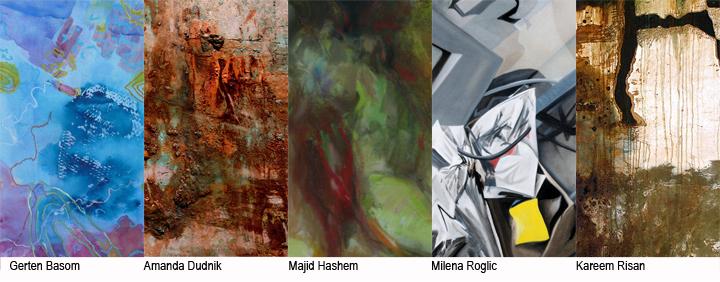Gallery Closure
The gallery is currently closed as we prepare for our next show. Join us for the opening reception to our members' show, SWARM, on Friday, December 12th from 7-9pm!
The gallery is currently closed as we prepare for our next show. Join us for the opening reception to our members' show, SWARM, on Friday, December 12th from 7-9pm!

Gerten Basom: Intrigued and inspired by the history of mapping and drawing from the tradition of plein air watercolour painting, I look toward bold colour, line, movement, rhythm and shape in directing the use of the watercolour and multimedia, in my paintings. Charting my interest in the natural world through the use of abstraction in these works, allows for a reinterpretation of traditional, literal methods of viewing. Instead, this method of painting creates a platform from which to reconsider or inquire about our approach to the environment, inspiring the notion of stewardship over ownership and conservation over consumption. Utilizing intuition at the core of these paintings is a freeing experience to think about a lot of other things. Considerable time is spent in thinking about and mixing colour, observing how these colours interact with one another as well as the substrate papers specifically and knowingly designed for the use of watercolour.
Amanda Dudnik is an emerging artist from Hamilton, ON. She graduated with an Honours Bachelor of Arts degree in Studio Art from McMaster University in 2012 and is currently a Masters of Fine Art candidate at the University of Windsor. Inspired by both industrial cities, her work investigates the dialog between urban and natural environments through painting. Dealing with ideas such as decay, regeneration, memory, phenomenology and psychogeography, abstractions of the minute encounters of the everyday are used as a subject matter that connects to the subconscious of the viewer. Amanda engages the painting surface through an introspective process, where the surface is built up in order to break down compositional elements to their essential features. Intentionally applying, removing and reapplying paint, a transitory experience is created through a visual confrontation with the surface beyond the surface.
Majid Hashem: My paintings are a mixture between realism and expressionism schools, but mostly tend to realism because Realism is my main interest. Previously l was teaching “sketching and coloring” at the Fine Arts Academy in (Babylon), Iraq. My vested interest in the human body, especially the female body is because I believe that it is the main source of beauty and the highest value of integration; by picturing this body I enlarge the whole that I have got either by sketching or coloring. I would say also my works depict those delicate bodies in non-stop rhyme and rhythm dancing in a colossal theater, crowded with activity and with colors on a huge stage.
Milena Roglic: I am interested in depicting the lingering atmosphere that exists between abandonment and renewal within transient environments by means of painting. My work represents a visual narrative based on personal interactions and observations of a constantly shifting urban landscape. Through the process of exploration, intuition and memory, my paintings reveal (aspects of) unstable and cluttered man-made materials, neglected architectural structures of recent past. Through photographic documentation, various images provide source material which reinforce memories of atmospheric and visceral tones drawn from personal expeditions. Each painting becomes a close-up encounter providing an intimate yet ambiguous experience of historical and industrial remnants combined with community presence and street culture. My aim is to offer the viewer enough representational forms to be relational while suggesting non-representational forms to galvanize uncertain and unknown sensibilities.
Milena Roglic is an emerging artist who was born in Hamilton and currently lives in Toronto. She is presently pursuing her MFA studies at York University. In 2004 she received and BFA (Painting and Drawing) from Concordia University and in 2001 a Fine Arts Diploma from Fanshawe College.
Kareem Risan: My Most Recent paintings represent wall sections displaying many images: indications, signs and text. They carry the message of the occurrences that have marred these spaces since the time they were first created. These series can either be approached by the viewer with this deep understanding, or considered through the viewers own interpretation. Similar to how wall slogans can be direct but can also invoke other elements. There are slogans in these paintings which can express cases and incidences. Such elements are either generated under the influence of the surrounding environment or as marginal elements within that environment, just like the randomly posted promotional prints, accumulation and denudations of chromatic layers on those same walls.